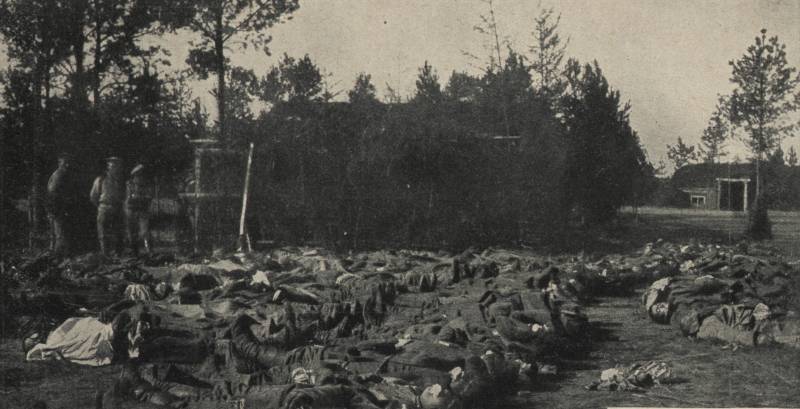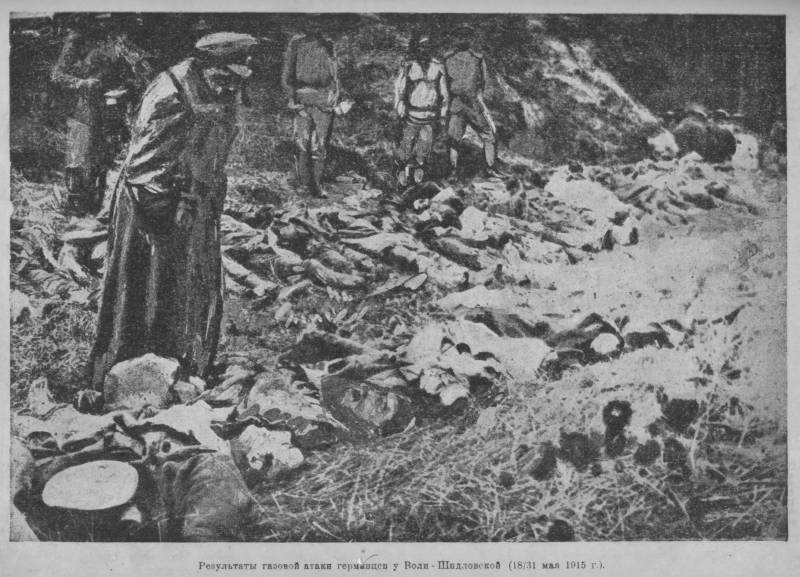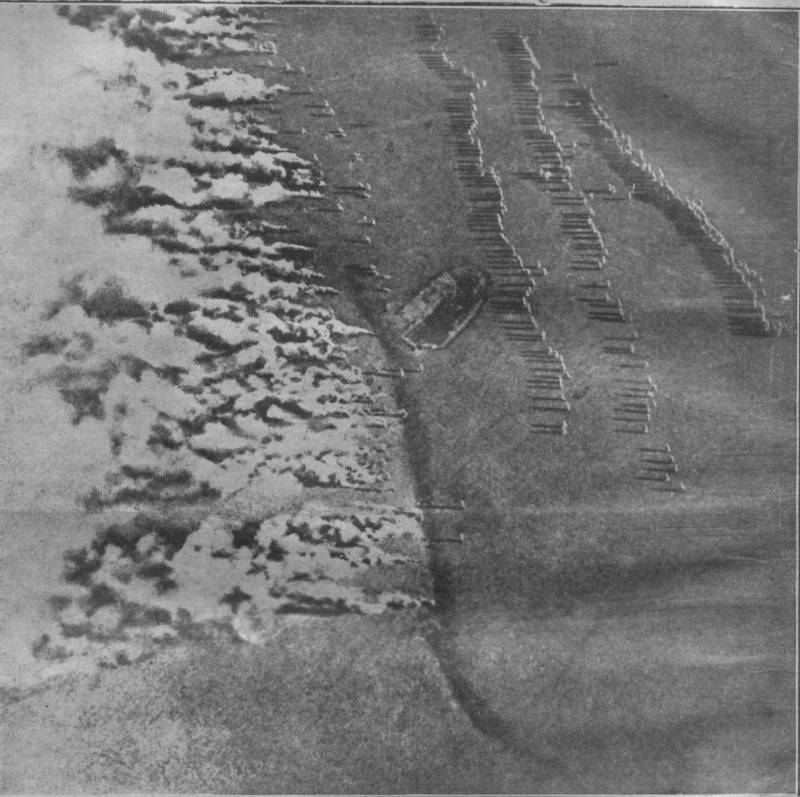In the clubs of a poisonous nightmare. "Poisoning with gas released by the Germans caused severe vomiting ..."
Gas strikes on the Russian defense
Already in December 1914, on the front of the river. Ravki German troops release suffocating gases from which a number of Russian soldiers suffered. This episode, in addition to the document, is mentioned in the memoirs of the commander-6 V.I. Gurko.
Then suffocating gases were used: 20.04.1915, under the village. Olshina and Rosenbark (Eastern Galicia), at the end of April of the same year on the site Jaslo - Gorlitsy - Frishtak. The first massive blow was an episode of 18 on May at Bolimov and Volya Shidlovskaya.
Then the enemy used a chemical weapon 27 and 28 of May (front of Humin - Borzhimov - Volya-Shidlovskaya), 20 of May (height of 902, Carpathians), 27 of May - 1 of June near Yaroslav, 2 of June at der. Kerkovitsy (near the town of Yavor), on June 14 near the r. The Dniester, on June 24, is again on the Sukha-Volya Shidlovskaya front, in late June near the town of Krasnostav, on July 1, near the town of Shavli, on July 24, under the Osovets fortress.
In the 1916 campaign, Russian troops withstood the 4 June chemical attacks on Krevo, June 19 and July 20 at Smorgon, September 9 at Naroch, September 12 at Ikskyulya, September Kroshin - Adakhovshchyna and September 24 at Baranovichi.
This is only about gas attacks. Artillery chemical strikes have been practiced with enviable regularity since January 1915 (under Borzhimov), and the Riga operation in August-September 1917 became the apogee.
For gas ballooning, chlorine was used mainly and bromine was used to kill the respiratory and circulatory systems. In the absence of protective measures, overwhelmingly poisoned, died, and few who survived remained crippled for a long time. A fair wind drove the poisonous gas released from the cylinders towards the Russian positions. A thick cloud of gas crawled over the earth, destroying all living things. And then followed suit attacks by properly equipped German troops.
The range of poisonous fillings for artillery shells was much richer.
We wrote about it. And now let's see - how the documents convey the atmosphere of repelling gas attacks - when Russian troops had to fight in the literal sense of the word in a gas nightmare.
Scary 18 May
From the magazine of military operations of the 6 Headquarters of the Siberian Army Corps. 18. 05. 1915 g. “By dawn 18 in May 1915, the corps headquarters, the 3-I Siberian division and the 54-th regiment of the 14-I Siberian division continued to remain in the army reserve. The position, from the mouth of the Nits River to the height 45,8 south of the village of Humin, was the 14-I Siberian Division, with the 55-th regiment occupied the right combat sector, and the 53 regiment - left combat sector, having in the reserve the 56 regiment in the village Chervona Niva. In addition, two hundred (1 and 4) 45 Don Cossack regiments were in position in the trenches.
Around 3 hours 30 minutes in the morning the enemy opened strong gun and artillery fire on the entire front of the division, on our light and heavy batteries, on observation posts and on the rear band of the division in the Chervona Niva and Ezhuvka area. Separate shells fell near the aerostat located between Gruzovy and Vyskitki and half a verst from the Oryshev farm on the highway from Oryshev to Vyskitki. Following this, a kind of greenish smoke screen appeared in front of the line of German trenches. Drawn by a fair wind, she moved to our trenches and clouded them. To 41 / 2 for hours, the smoke that turned out to be chlorine-containing gas enveloped not only the trenches, but also the immediate surroundings, including even places relatively remote from the positions of the master yard Orryshev and Posk Viskitki (and here and there there were cases of gas poisoning). Being heavier than air, the gas released by the Germans spread on the ground, sank into lowlands and trenches and stayed there for a long time ...
In the whole space from the position to Oryshev, under the influence of gas, the spring shoots, the flowers, and especially the clover that had just begun to bloom, which flowers immediately dried, turned yellow. The effect of gases on people in close proximity to the German trenches, in trenches and on batteries was all the more destructive. The use of gases by the Germans came as a surprise to people in the trenches, and many at first observed with curiosity the appearance of smoke in front of the German trenches. Then, when the gases began to exert their effects, some people tried to escape from them, covering their faces with handkerchiefs and wetting them with water, where they found themselves, and many rushed back along the message and bluntly, trying to escape from the gases. Soon the trenches and, in particular, the lines of communication turned out to be places filled with poisoned bodies lying in several rows. People, ebbing back in the direction of gas, fell along the road. Soon, dressing stations, hospitals and hospitals in Guzov, Viskitki, Zirardov and Terezin were overwhelmed with poisoned ones. Poisoning with gas released by the Germans caused severe vomiting and bloody foam from the mouth. The breathing of the diseased accelerated tremendously. Many completely chenille and died with signs of suffocation. Due to the novelty of the phenomenon and mass poisoning, doctors were powerless to more radically help the poisoned.
As a result, as it turned out later, only in two divisions of the division - 53 and 55 - on the day of 18 on May and the following days, when the gas remaining in the trenches continued its disastrous effect, 33 of the officer and 5752 of the lower ranks of the total 74 officers and 7118 of the lower ranks of these regiments. Especially heavy losses were in the 53 regiment, in which 35 dropped out of 17 officers and from 3788 lower ranks - 3441 or about 90%. Of the above number of officers, according to information available in units and hospitals, 10 officers died, and from the number of lower ranks 849 or about 15%; however, these data cannot be considered exhaustive, as there were fatal cases during the evacuation from hospitals to the rear ... A total loss in people from the action of gases could be considered in round numbers of 6000 people.
After waiting a few times to allow the gases to act, the Germans, with chains and individual companies, went on the attack, sending it mainly to the right flank of the 55 regiment, to the front of Zakrzhev, Sucha; attempts to attack were in other places. Despite the enormous losses, from the trenches of the 55 and 53 regiments, the attackers still opened rifle and machine-gun fire; Artillery also opened fire, and the German attacks were repulsed with considerable losses for them.
Around the 6 hours of the morning, the Germans began to accumulate at the mouth of the Nits and managed to transfer some parts across the river, but could not establish themselves and soon one by one began to run back. At o'clock in the morning, the enemy made another attempt to attack the 71 regiment of the 2 / 55 regiment, but also it failed, after which calm was restored at the front, and the enemy began to withdraw reserves to the rear.
A gas was also fired against 35 Army Corps, which was located next to us on the left, after which, around 4 hours of the morning and later, around 2 hours of the day and 10 hours, the enemy tried to attack in the area of Will Shidlovskaya, but was beaten off by our fire. Part of the 55 division, which occupied the trenches in the area, suffered great losses in people who had fainted from the inhalation of asphyxiating gases. In total, 26 officers and 3070 lower ranks failed, however, the percentage of deaths was lower than in the 6 Siberian Corps.
Against the 5 of the Siberian corps, adjacent to the right, apparently, an attempt was also made to launch gas, but it failed, and the gas did not reach our trenches. Attempts of partial offensive success were not.
The 48 prisoners of the 5 reserve regiment of the 3 reserve division of the reserve corps, taken north of the Sochachev-Lovich 55 railway by the Siberian regiment, showed that about 10 - 14 days ago in the trenches, from Bzura to Boli Shidlovskaya, gas batteries were installed from 8 — 12 tanks with condensed gas containing chlorine. These batteries were separated from each other at a distance of about 30 steps. The Germans were waiting for a fair wind in order to release gas to our trenches and then launch an offensive on the front about 10 versts in order to seize our trenches. German officers tried to convince the soldiers that there would be no shooting from the Russian trenches after the gas was fired. Parties were appointed to cut our wire fences; the attacking units were to follow these parties, followed by teams with oxygen apparatuses to bring people who were ill with gas to their senses. Reserves were pulled into the trenches. German soldiers did not believe too much in the efficacy of the gases and were afraid to go on the attack. The shooting that started from our trenches kept the majority in the trenches, and the units that tried to go on the offensive were met, as already indicated above, with our fire and, having suffered losses, went back to their trenches.
Thus, the operation, widely conceived by the enemy, in which poisonous gases were used for the first time, and unexpectedly for us, failed because of the resilience and courage of 53 and 55 of the Siberian regiments and Cossacks, who, choking on poisonous gases, fired at the enemy and forced him stay in their trenches.
But what is said in the polling report of the Deputy Chairman of the Central Military Industrial Committee V. V. Zhukovsky from 30 in May 1915. “We traveled the entire affected area for about 30 miles. All affected by gas were about 7000 people. All this was on the front of the river Bzura at Volya Shidlovskaya. According to the stories of the lower ranks, the officer-commander of the battery and others, it was as follows: at night, the lower ranks heard whistling and hissing, as if the locomotive horn sounded in the enemy's trenches. Then, from there, towards our trenches, clouds of yellowish-brown color taller than a man's height began to move. These were suffocating gases that drove the wind along our trenches for about 11 / 2 miles. People habitually hid in the trenches, where they were, unfortunately, overtaken by gas. They instinctively covered their mouth and nose with what could be, the officer gave by telephone an order to wet the scarves with water and breathe in them, which really gave relief; The people who thought to jump out of the trenches, approximately, the 7-8 man on the company, began to operate from machine guns against the advancing enemy, and the attack was repelled.
The changed wind drove the gases on the Germans, who themselves suffered from them. When examining our impressed soldiers, I observed a severe form of emphysema, a tumor in the upper chest and neck, and the skin was colored bluish. People inexpressibly suffered, and a groan came from all sides. The picture was amazing: the poisoned people apparently suffered and suffered more than after the injury, there were also complaints that the authorities did not foresee this disaster and did not protect the soldiers and officers. There was with it a terrible bitterness against the enemy and a thirst for revenge. On the first day, May 18, out of “gas-stricken people, about 1400 people died. Mortality was particularly high during the first period of the disease. ”
To be continued ...



Information